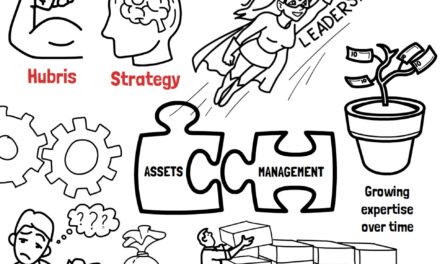How Seed Accelerators are Building the Economy, One Startup at a Time
How Seed Accelerators are Building the Economy, One Startup at a Time

In Brief: Seed accelerators spur investment in startup companies, particularly by Corporate Venture Capital (CVC) firms.
Why This Matters: Normally risk-averse CVCs are investing in regions and technologies where they traditionally have not, spurring overall regional economic growth.
The Takeaway: Seed accelerators help startups by honing their ideas and pitches; they help investors by ‘vouching for’ a startup, thereby easing concerns about investing in companies that come from regions not normally known for innovation and in technologies that are “out of the box” of the CVCs’ parent companies.
In Depth:
When Courtney McColgan realized that there was no good human resources software for her employees at Cabify, an Uber-like ride sharing app in Latin America, she set out to develop one herself. The result: Runa HR, a cloud-based platform that handles all things HR. Within a week of presenting to would-be investors, Runa HR had raised over $3 million in venture capital, including from Salesforce Ventures, salesforce.com’s corporate venture capital arm.
That such substantial investment was made in such a short time period is remarkable enough. But there are other factors that make this story noteworthy, says Raveesh Mayya, a fifth-year PhD candidate with the Robert H. Smith School of Business at the University of Maryland: Runa HR is a Latin American company that had a substantial investment early on by a corporate venture capital (CVC) firm. This, Raveesh tells me, is remarkable. While independent venture capital firms are solely looking for financial gain, CVCs goals are more nuanced, looking also to learn about new technologies, and how they’ll be used in the future. What’s more is that these types of early-stage investments by CVCs in startup companies that are headquartered in places other than the tried-and-true investment hubs like Silicon Valley have increased exponentially in the last few years. In fact, 2018 saw a 35% increase in first-time CVC investment over 2017. The highest number ever of CVCs invested the fourth quarter of 2018. What could be driving this growth, Raveesh wondered.
As part of his studies with the Ed Snider Center, Raveesh learned that startups, which have helped fuel unprecedented entrepreneurial economic growth in the United States, have been greatly aided in the last few years by ‘seed accelerators.’ These companies, also known as ‘startup accelerators,’ provide select startup companies with an intensive, limited partnership, where they’re provided seed funding, and mentored. Ultimately, these startups present their ideas to would-be investors, curated by the seed accelerator. The seed accelerator acts as an intermediary between the startups and investors. Runa HR worked with Y Combinator, a seed accelerator that invested $120,000 in the company, working to help Runa HR hone its pitch and secure venture capital. Founded in 2005, Y Combinator was the first seed accelerator in the world. Today, a little over a dozen years later, there are hundreds of similar companies worldwide.
Raveesh was interested in researching how these seed accelerators impacted investment behavior. The results were published in his working paper “Seed Accelerators and Information Asymmetries: Evidence From Corporate Venture Capital Investments,” which was awarded the Nancy S and Edward F Ebert Graduate Award in Free Enterprise. Together with his co-investigator, Dr. Peng Huang of the Smith School, they focused their research on the investment behaviors of Corporate Venture Capitalists (CVCs), which could benefit greatly by investing in startups, but are traditionally reticent to do so. “A key hurdle that a free market faces is the asymmetric information between transacting partners,” Raveesh said. “Issues stemming from asymmetric information may make transactions in the market less efficient, threatening the free market.” CVCs in particular are affected by this. Traditionally, when CVCs have invested in startups, they’ve done so quite conservatively—later in the life of a startup, and rarely in a startup whose mission differs from that of the CVCs parent organization. But seed accelerators appeared to change this trend: initial research found that when seed accelerators began working with companies in a particular region, an increase in investment in that region followed. But where research lagged was how and why the incursion of seed accelerators into a particular region changed investment patterns. Raveesh and Peng wondered if one of the reasons for the increase in investments was because the presence of seed accelerators alleviated problems associated with asymmetrical information.
Together, the pair tested their hypotheses—that seed accelerators do increase the number of investments made by CVCs in a particular area, and in turn spur CVCs to invest earlier, and in technologies that are beyond the scope of their parent companies. Using data modeling, Raveesh and Peng found that CVCs do invest more heavily in an area once seed accelerators set up operations there, and they do invest earlier, and in technologies that differ from their parent companies’ focus—with promising results. Aiding with the discovery and valuation process, they wrote, was one of the primary functions of a seed accelerator. This, Raveesh said, is particularly important to be able to convince CVCs that startups that work with seed accelerators are a potentially good investment. Raveesh also explained that it’s important from an entrepreneurial standpoint: “Seed accelerators help innovation in places that are not normally known for it,” he said. “Traditionally, CVCs have invested in places like Silicon Valley, which is known for its innovation. They’ve invested late in the game, and have stuck to investments that are very similar to their parent companies.” But seed accelerators effectively vet startups, and then mentor them. So, potential CVC investors understand that these startups have been “vouched for” by the seed accelerators. This can be particularly useful when there are significant cultural barriers, like language differences. This enables the CVCs to identify startups that are a good fit, and enables these investors to take risks, especially when the investee’s technology differs from that of their parent companies. “This provides a window into the future technologies for companies,” Raveesh said. Certain technologies might not be a priority for a CVCs parent company today, he went on to explain, but they might down the road, as things evolve. “Our research shows that seed accelerators may act as an intermediary that may mitigate the issues stemming from assessment and valuation problems,”Raveesh said. “This doesn’t just increase investments in a particular region, but also helps investors achieve their stated goals of investment.” And that, he said, is great news for the economy of that region.
In a blog post, Runa HR’s founder wrote,“As a Latin American startup, many investors in Silicon Valley won’t even take your meeting.” But, she added, Y Combinator helped change that dynamic entirely. “I can say that no investor ever said no to meeting with us.”
Lia Kvatum is a freelance writer and producer based in Washington, DC. In addition to the Ed Snider Center, her clients include The National Geographic Society, The Smithsonian Institution, PBS, and the Washington Post. More of her work can be seen at LiaKComms.com.




